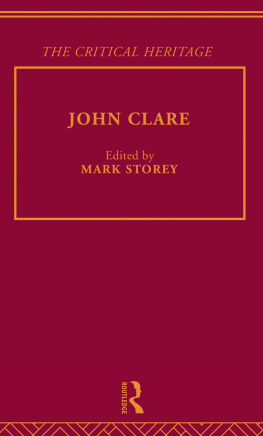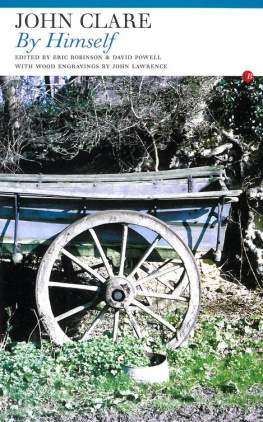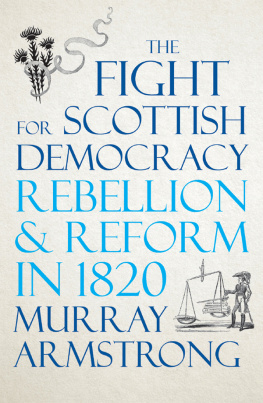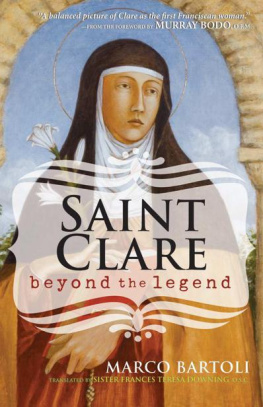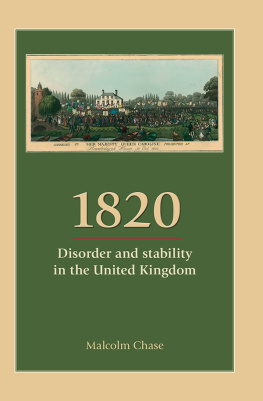
JOHN CLARE: THE CRITICAL HERITAGE
THE CRITICAL HERITAGE SERIES
General Editor: B.C.Southam
The Critical Heritage series collects together a large body of criticism on major figures in literature. Each volume presents the contemporary responses to a particular writer, enabling the student to follow the formation of critical attitudes to the writers work and its place within a literary tradition.
The carefully selected sources range from landmark essays in the history of criticism to fragments of contemporary opinion and little published documentary material, such as letters and diaries.
Significant pieces of criticism from later periods are also included in order to demonstrate fluctuations in reputation following the writers death.
JOHN CLARE
THE CRITICAL HERITAGE
Edited by
MARK STOREY

First Published in 1973
This edition published in the Taylor & Francis e-Library, 2002.
11 New Fetter Lane
London EC4P 4EE
&
29 West 35th Street
New York, NY 10001
Compilation, introduction, notes and index 1973 Mark Storey
All rights reserved. No part of this book may be reprinted or reproduced or utilized in any form or by any electronic, mechanical, or other means, now known or hereafter invented, including photocopying and recording, or in any information storage or retrieval system, without permission in writing from the publishers.
British Library Cataloguing in Publication Data
ISBN 0-203-19943-X Master e-book ISBN
ISBN 0-203-19946-4 (Adobe eReader Format)
ISBN 0-415-13449-8 (Print Edition)
General Editors Preface
The reception given to a writer by his contemporaries and near-contemporaries is evidence of considerable value to the student of literature. On one side we learn a great deal about the state of criticism at large and in particular about the development of critical attitudes towards a single writer; at the same time, through private comments in letters, journals or marginalia, we gain an insight upon the tastes and literary thought of individual readers of the period. Evidence of this kind helps us to understand the writers historical situation, the nature of his immediate reading-public, and his response to these pressures.
The separate volumes in the Critical Heritage Series present a record of this early criticism. Clearly, for many of the highly productive and lengthily reviewed nineteenth- and twentieth-century writers, there exists an enormous body of material; and in these cases the volume editors have made a selection of the most important views, significant for their intrinsic critical worth or for their representative qualityperhaps even registering incomprehension!
For earlier writers, notably pre-eighteenth century, the materials are much scarcer and the historical period has been extended, sometimes far beyond the writers lifetime, in order to show the inception and growth of critical views which were initially slow to appear.
In each volume the documents are headed by an Introduction, discussing the material assembled and relating the early stages of the authors reception to what we have come to identify as the critical tradition. The volumes will make available much material which would otherwise be difficult of access and it is hoped that the modern reader will be thereby helped towards an informed understanding of the ways in which literature has been read and judged.
B.C.S.
Contents
An enquirer after Clares welfare, March 1820
Unsigned notice, Literary Gazette, March 1827
SPENCER T.HALL on Clare and Bloomfield, March 1866
ROBERT GRAVES on Clare as a true poet, 1955
Preface
This volume contains most of the reviews and notices of Clares work that appeared in his lifetime, except those that were entirely biographical. Many of these early reviews were written by uninspired, journeymen critics, now anonymous; but they still have their value. Some make points that have always been important in discussions about Clare, others reflect the particular concerns of the time. The assumptions and contradictions lurking behind all these accounts are interesting in themselves, for the light they throw on reactions to other poets of the period, as well as for what they show of the response to Clare.
The numerous letters written to Clare are well represented, as they constituted a powerful form of encouragement and persuasion. In the extracts from letters from Mrs Emmerson, Octavius Gilchrist, Edward Drury, Taylor and Hessey, we can see something of individual readers responses which qualify and enlarge upon the more formal reactions of the reviews. Extracts from Clares own letters help to show what effect these pressures had on him.
For the period after Clares death, the documents are necessarily of a different kind, and rather more selective. Each document has its own special interesthistorical, critical, or even biographical (as this affects critical attitudes). Although most of the important responses are represented, there is nothing from the standard biographies by J.W. and Anne Tibble. These two works have played a crucial part in the revival and maintaining of interest in Clare this century, and some reactions to them are recorded here; but it would have been a travesty of their scope and intentions to pick and choose passages from them.
Documents are arranged chronologically. In one or two instances, however, a particular issue or theme is followed through, under one heading, so that, for example, the various views on a particular poem are gathered together, as are the differing opinions on matters of indelicacy, within a particular period. The general scheme is further broken up by a focusing of each of the early sections upon a particular volume. Therefore the critical reactions to Poems Descriptive of Rural Life and Scenery are to be found in sequence, and a separate section charts comments (usually from letters) on the growth of what was to become The Village Minstrel, even though this results in some chronological overlapping between sections. Each volume of Clares poems, published in his lifetime, is treated in the same way; I hope the greater pattern and order that results does not entirely eliminate the sense of a series of gropings towards some kind of critical truth.
Acknowledgments
I should like to thank the following for permission to reprint copyright material:
G.Bell and Sons, Ltd for C.H.Herford, The Age of Wordsworth; Basil Blackwell and Mott Ltd for an article by Alan Porter in Oxford Outlook; Mr Edmund Blunden for Votive Tablets; Cambridge University Press for Hugh Walker, The Literature of the Victorian Era; the Clarendon Press, Oxford for C.C.Abbott, ed., The Life and Letters of George Darley, for an article by Leslie Stephen in Dictionary of National Biography, for Arthur Symons, the Introduction to Selected Poems of John Clare, and for an article by J.W.R.Purser in Review of English Studies; Cornell University Press for Harold Bloom, The Visionary Company: A Reading of English Romantic Poetry; the Daily Telegraph and Morning Post for an article by Edmund Blunden; J.M.Dent and Sons Ltd for E.V.Lucas, ed., The Letters of Charles and Mary Lamb; Mr Geoffrey Grigson for the Introduction to Selected Poems of John Clare; William Heinemann Ltd for Maurice Hewlett, Last Essays, and for Edmund Gosse, Silhouettes;
Next page
